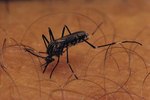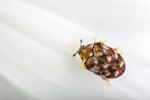
The phrase "medically important" makes it sound like these insects make some contribution to further medical science; however, in this case, "medically important" insects means those that cause medical problems. Some transmit disease, sting, drink blood or lead to allergic reactions in humans. In addition to occasionally being deadly, even small bites and stings can lead to increased health-care costs and absenteeism from work, putting a financial strain on our economy.
Mosquitoes
Mosquitoes are one of the main disease carriers among insects. They bite multiple people and animals, and when they bite, they regurgitate a small amount of their stomach contents into the new host. If a mosquito previously bit an infected person or animal, he can transfer that disease to the new host. Diseases commonly passed by mosquitoes include malaria, West Nile virus, encephalitis and yellow fever.
Flies
A variety of flies are medically important. They often eat food we consider undesirable, such as rotting vegetation and feces. This can cover their bodies in diseased particles, including their mouth parts, feet and legs. When a fly lands on food you're about to eat, he can deposit some of those particles on your food, leading to food poisoning for you. Flies also transmit diseases such as typhoid and cholera.
Bees and Wasps
While bees and wasps don't typically spread disease, stings are common. Depending on where you're stung and the power of your immune system, most stings are fairly benign, leading to a red, painful, sometimes itchy bump that fades in a few days. However, some people are allergic to the toxin in bee stings. They can experience swelling and tenderness in a large area around the sting. In extreme cases, the person can experience anaphylactic shock and die without immediate medical treatment.
Bed Bugs
Bed bugs get their name from their proclivity to live in and around your bed. They feed on blood, climbing on you as you sleep and feasting while you're still. Their bites can cause severe redness and itching. A couple of bed bugs might not seem like a big deal, but the problem is that you never have only a few. They're fast breeders and hard to kill. They can hide in your carpet, your clothes or even inside your walls. In large groups, bed bugs can drink so much blood over time that you can suffer effects of blood loss such as anemia and lack of energy -- in extreme cases, death. It's true that it's best to not let the bed bugs bite in the first place.
Bugs in Medicine
Some insects that we typically see as pests can be useful in medical situations. Although currently not used in mainstream American medicine, doctors occasionally use bugs to help treat cases where traditional medical care hasn't worked effectively. Fly maggots, for example, can help clean wounds by eating necrotic tissue. Their work induces healing and helps prevent infection. In people who aren't allergic to bee stings, these stings can actually help relieve chronic pain and inflammation, such as that from arthritis. The bee venom, and some ant venom, has anti-inflammatory properties some patients can benefit from. A topical cream made from the bodies of blister beetles helps warts and other skin conditions. Scientists also use insects as inspiration for new technology, such as creating tiny cameras used for surgery that mimic the compound eyes of ants so doctors have a better view and designing a fly-inspired camera that can help find trapped disaster victims faster than traditional grid searches.
References
- Northern Territory Government: Disasters and Medically Important insects in the Northern Territory
- Mahidol University: Epidemiological Investigation of Outbreaks of Vector-borne Diseases
- Texas A&M AgriLife Extension: Good Bugs and Bad Bugs
- North Carolina State University: Pests of Medical Importance
- Alternative Medicine Review: Bugs as Drugs, Part 1 -- The "New" Alternative Medicine for the 21st Century?
- Newsday: Insects Inspire Medical Research
Photo Credits
-
Hemera Technologies/Photos.com/Getty Images




